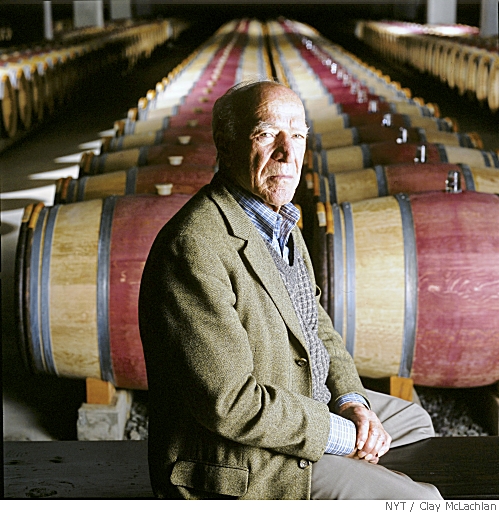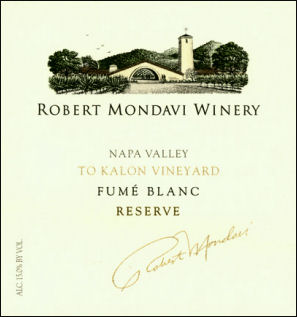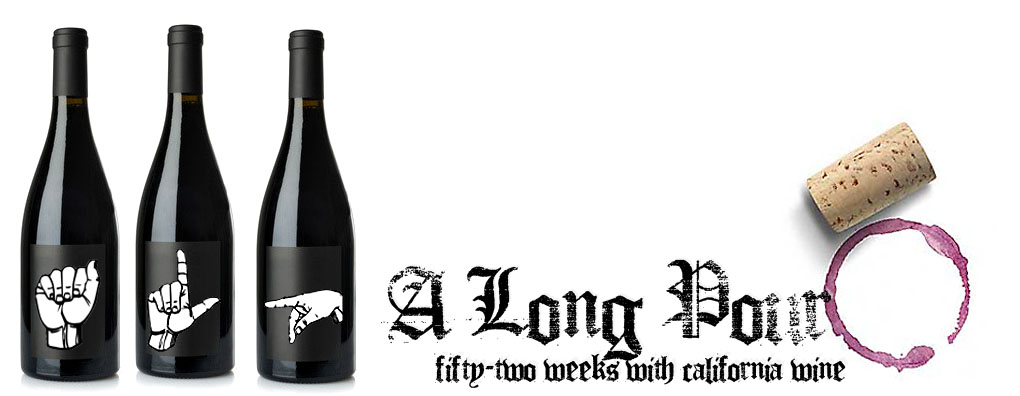Mondavi, King of the Valley
I know…I know…Mondavi is probably not the direction you would like to see me going with this project, especially after several posts on family wineries emphasizing environmental sustainability. But, I have my reasons for profiling Mondavi this week.
The first and most important reason is that you cannot talk about the history of California wine without talking about the efforts of Robert Mondavi. Like it or not, the empire he built is one of the key reasons California enjoys the global recognition it has today. The second reason, is one of logistics, like most Internet writers, I have a real job that keeps me quite busy. While I love to publish interviews with winemakers and proprietors as often as possible, I simply cannot visit all of them in person. By the time a profile gets published on the site, there are usually weeks and months of emails and phone conversations that have gone into the article. Winemakers are busy people, and although I have a dozen wineries waiting for their chance to shine, I simply have weeks with gaps in content because interviews have not been completed. This is one of those weeks. I promise some real interviews starting again next week. I will work to keep these kinds of posts to a minimum, but in certain instances like this week, they have their place.
If you are still angry that I’m writing about Mondavi, then please feel free to donate to the “Help Wayne Write About Wine Full-time So We Don’t Have to Read About Mondavi Fund”. My PayPal is wkelterer@gmail.com. All donations are welcomed. Just put “No Mondavi Profiles” in the subject line. Anyone that donates by next Thursday will go into a random drawing and I will send he or she something fun. Seriously.
OK, since I am expecting my PayPal account to see about as much action as a senior citizen bingo hall on a Wednesday night, you are stuck with a Mondavi story. But fear not, for the Mondavi’s epic story is full of ambition, greed, power, and heartbreak.
I guess as a starting point, we must answer the question: why would someone care if I profile Mondavi? To be honest, I care. Ideally, I try to work with smaller operations that still have family involvement, not just the family name. This is not a requirement, but I strongly prefer it. For one, larger wineries (some do millions of cases a year) have massive marketing budgets and do just fine getting their message and wine out to the masses. Small wineries often rely on ratings in publications like Wine Spectator, The Wine Advocate, wine events, and word of mouth to get their product into consumer’s hands. However, my biggest aversion to profiling the Mondavi Winery is its corporate approach to what I feel should be an intimate craft. The globalization of what was once a family name.
It wasn’t always like that though…
If you set out to chronicle the history, the whole history, of the Robert Mondavi story, you will soon realize it deserves a book and not just a small article on the Internet. Recently, I have been reading such a book. “The House of Mondavi – The Rise and Fall of an American Wine Dynasty” by Julia Flynn Siler. It is a fascinating and well-researched account that at times seems more like the script for a T.V. drama than real life. But the Mondavi story started where it should, with a desire to make something great.
Robert Mondavi’s father Cesare, an immigrant from Italy, built a successful grape and fruit wholesaling business based out of Lodi California, in the San Joaquin Valley. He raised four children including two boys, Robert and Peter; Robert being only fourteen months older than Peter. However, it wasn’t only in birth Robert would come first.
At Robert’s urging and with some help from his mother, Cesare purchased the Charles Krug Winery, one of the oldest wineries in the rural Napa Valley. There, the two brothers would learn the craft of winemaking and the art of sales. Peter, who previously studied and worked on cold fermentation at UC Berkley, showed a special skill for winemaking and with Robert’s innate genius for marketing, it wasn’t long before the wines of Krug were receiving national attention, as was Robert. Although Peter crafted the wine, most of the credit and praise went to his older brother.
 This was only one of a series of conflicts between the two. Everyday on his way to the winery, Peter drove past one of the homes on the property where Robert and his family lived nearly rent-free for years. The press loved Robert, while largely ignoring the efforts of Peter. It was Robert having his picture taken. It was Robert being invited to posh parties and State affairs. Even in family matters, it was Robert’s opinion that seemed to hold sway over his younger brother’s. The divisions eventually led to a split between the two, with Robert leaving Krug to starting the Robert Mondavi Winery in 1962.
This was only one of a series of conflicts between the two. Everyday on his way to the winery, Peter drove past one of the homes on the property where Robert and his family lived nearly rent-free for years. The press loved Robert, while largely ignoring the efforts of Peter. It was Robert having his picture taken. It was Robert being invited to posh parties and State affairs. Even in family matters, it was Robert’s opinion that seemed to hold sway over his younger brother’s. The divisions eventually led to a split between the two, with Robert leaving Krug to starting the Robert Mondavi Winery in 1962.
Needless to say, the decades that followed brought tremendous success for the Robert Mondavi brand and for California wine in general. By 1975, Mondavi was shipping their wines all over the Country and by 1977, began shipping internationally. The Judgment of Paris, where participants such as Chateau Montelena and Stags Leap competed with great success against French wines (many assumed there would be no competition between the two and thought the whole thing laughable), added to the fame of California wines. The Mondavi brand was becoming a common household name not only to American families, but the families of the world as well.
But the success came with a price. Family feuds and lawsuits plagued the Mondavis. In the early 90’s, with Robert in his late 70’s, he gave control of the company to his sons, Michael and Tim. However, this was not a bright spot in the company’s legacy. With a 500,000 case a year production and $145 million in revenues, the company was carrying $126 million in debt. In order to raise funds and keep control of the winery, the Mondavis went public in 1993. Within a few short years, case production soared to 4.5 million annually. The rest of the 90’s saw expansion in advertising, the purchase of other wineries, and a deal with Disney.
But by the 2000’s, the Mondavi’s were loosing much of the control over their legendary brand. The Robert Mondavi Winery’s official website has a company time-line, with an interesting gap in it: 1968, first Cabernet vintage released; 1976, Tim Mondavi takes charge; 1979, Woodbridge Winery founded. 1996: Robert Mondavi carries the Olympic torch; however, 2004 is blank as if nothing of note happened. Yet, the year has as much or more significance than any other year of Mondavi’s nearly 50-year history. A series of events lead to the “resignation” of Michael Mondavi from the Board of Directors, although in effect, he had been fired. The end of 2004 brought the transfer of an empire started by two brothers on the west coast, Robert and Peter, to a new growing empire run by two brothers on the east, Richard and Robert Sands, Chairman and President of Constellation Brands. Mondavi was sold for a staggering $1.36 billion dollars. With the close of 2004, one of the greatest chapters in California’s wine history had come to an end. The Sands brothers, with a deep family history in cheap bargain wines would look to rebuild the brand into its former glory.
Robert’s health was said to fade quickly after the events surrounding the transfer in ownership and on May 16, 2008, Robert died. The Mondavi family remains highly invested in wine. Tim Mondavi started Continuum Estate and Michael Mondavi along with his family own Folio Fine Wine Partners as well as M by Michael Mondavi.
The sum of all parts, the Mondavi’s lost sight of their original goal: to craft world-class wines in their beloved Napa Valley. Yet, a corporation is not inherently bad. What a few individuals or a family operation can do well, a corporation might do infinitely better. I am glad my cell phone is through Verizon and not Crazy Gideon’s Mid-town Mobile. Certain global products require global solutions. We can accept that. But wine…?
If wine is to be an expression of place and time, not everyone can experience the same thing. A winemaker in Santa Barbara told me, “the great thing about wine is you will never know it all”. With thousands of wineries all over the World making wines that reflect the vineyards they grow in and effects that the vintage’s weather had on the fruit, the opportunities are endless to experience something unique, a wine of character. However, a corporate goal to “get this into every family’s shopping basket” can never really provide a wine with a true sense of place and time. It becomes a bulk commodity, like soda, or boxer briefs.
As for Mr. Mondavi, my hat is off to him for all that he achieved. Say what you will about the company’s approach to wine in later years, but agree with it or not, no one can take away what Robert achieved for American and even global wine. Mondavi may have strayed from the indented path, but Robert’s trailblazing helped lead the way for countless others. And as for the Robert Mondavi Winery? The spirit of what Robert once did there cannot be kept alive by the mere use of a name. Only time will tell if Constellation Brands can rebuild the prestige the name once commanded.
Much of my research came from Julia Flynn Siler’s book, ‘The House of Mondavi”. The true story of the Mondavi family is so much more complex then I can do it justice and I highly recommend the book for any who are interested in a history of the winery, as well as Napa Valley. Also of interest, may be “Mondavino”, a 2004 documentary film that looks at globalization in the wine world. Michael, Tim, and Robert are key characters. Although enlightening, I suggest you watch it with the understanding that it is rather one sided.
Highway 29
Oakville, CA 94562
(888) 766-328
Photo of Robert Mondavi, credit Clay McLachlan, NYT


